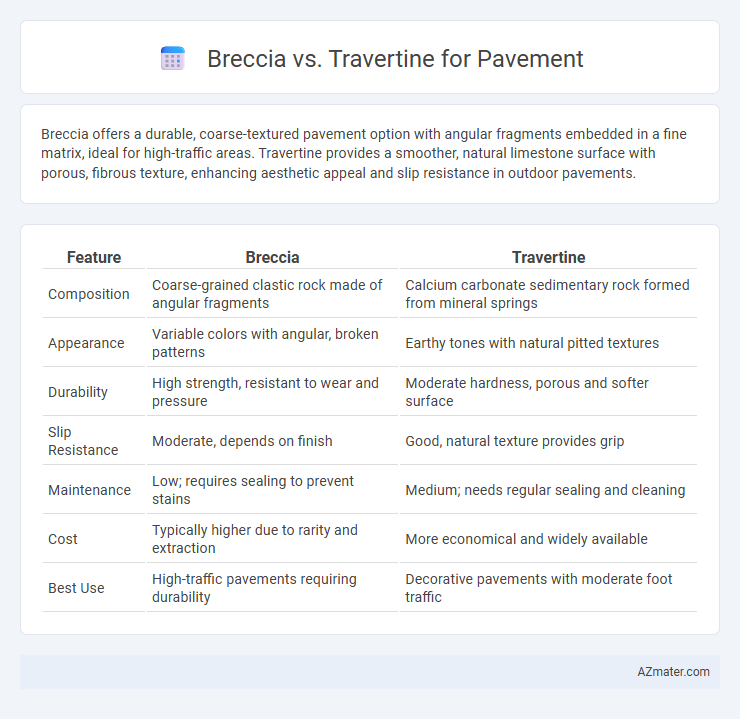Breccia offers a durable, coarse-textured pavement option with angular fragments embedded in a fine matrix, ideal for high-traffic areas. Travertine provides a smoother, natural limestone surface with porous, fibrous texture, enhancing aesthetic appeal and slip resistance in outdoor pavements.
Table of Comparison
| Feature | Breccia | Travertine |
|---|---|---|
| Composition | Coarse-grained clastic rock made of angular fragments | Calcium carbonate sedimentary rock formed from mineral springs |
| Appearance | Variable colors with angular, broken patterns | Earthy tones with natural pitted textures |
| Durability | High strength, resistant to wear and pressure | Moderate hardness, porous and softer surface |
| Slip Resistance | Moderate, depends on finish | Good, natural texture provides grip |
| Maintenance | Low; requires sealing to prevent stains | Medium; needs regular sealing and cleaning |
| Cost | Typically higher due to rarity and extraction | More economical and widely available |
| Best Use | High-traffic pavements requiring durability | Decorative pavements with moderate foot traffic |
Introduction to Breccia and Travertine
Breccia and travertine are natural stones commonly used in pavement applications, each offering distinct aesthetic and functional properties. Breccia features angular fragments cemented together, providing a unique, variegated texture ideal for rustic and decorative surfaces. Travertine, formed from calcium carbonate deposits in mineral springs, exhibits a smooth, porous texture with natural veins, making it a durable and elegant choice for outdoor and indoor flooring.
Geological Origins and Formation
Breccia is a sedimentary rock composed of angular fragments cemented together, formed from rapid geological processes such as landslides or volcanic eruptions, creating a coarse texture ideal for rugged pavement surfaces. Travertine originates from calcium carbonate deposits precipitated from mineral-rich hot springs, exhibiting a smooth, porous structure with distinctive banding patterns, commonly used for elegant, slip-resistant flooring. The contrasting geological origins influence their durability and aesthetic properties, with breccia providing strong mechanical stability and travertine offering natural heat resistance and visual appeal in pavement applications.
Physical Properties Comparison
Breccia features a coarse and angular clastic texture with high compressive strength ranging from 80 to 120 MPa, making it suitable for heavy traffic pavement applications. Travertine, characterized by a porous, fibrous structure and lower compressive strength of approximately 40 to 70 MPa, offers excellent slip resistance but requires sealing for enhanced durability in outdoor pavements. Both stones exhibit good abrasion resistance, but Breccia's denser composition results in superior load-bearing capacity compared to the more porous Travertine.
Aesthetic Appeal: Color and Texture
Breccia pavement offers a striking aesthetic appeal with its bold, angular fragments and varied mineral composition, creating a dynamic mosaic of earthy tones and rich textures ideal for adding visual interest. Travertine, known for its subtle, uniform hues ranging from creamy beige to warm gold, features natural pitting and smooth, matte surfaces that provide a timeless, elegant look perfect for luxurious, classic settings. Both materials enhance outdoor spaces with unique textures and colors, but breccia's dramatic patterns contrast with travertine's gentle, harmonious appearance in pavement design.
Durability and Strength Analysis
Breccia and travertine both offer unique characteristics for pavement applications, with breccia exhibiting superior durability due to its composition of angular fragments cemented in a dense matrix, resulting in high compressive strength and resistance to wear. Travertine, while aesthetically pleasing with its porous surface and natural veining, generally has lower strength and is more susceptible to surface erosion and weathering under heavy traffic conditions. For long-term pavement installations, breccia's robust structural integrity ensures better performance in high-stress environments compared to the relatively softer and more porous travertine.
Slip Resistance and Surface Safety
Breccia offers excellent slip resistance due to its coarse, irregular texture that provides natural grip, making it a safer choice for pavement in wet or high-traffic areas. Travertine, while visually appealing with its smooth, porous surface, tends to be more slippery when wet unless treated with a non-slip finish or honed to increase traction. Selecting Breccia for pavement enhances surface safety, especially in outdoor environments requiring durable, slip-resistant flooring solutions.
Cost and Availability Factors
Breccia tends to be more expensive than travertine due to its rarity and complex quarrying process, which affects overall pavement project budgets. Travertine is widely available and more cost-effective, making it a popular choice for large-scale pavement installations. Cost-efficiency and consistent supply often make travertine preferable where budget constraints and material accessibility are critical factors.
Installation and Maintenance Requirements
Breccia requires careful installation due to its uneven surface and hardness, often demanding professional cutting tools and skilled labor to ensure stable pavement. Travertine offers easier installation with its uniform thickness and natural pitted texture, which can be filled to create a smooth surface, reducing slip hazards. Maintenance for Breccia includes periodic sealing to prevent staining and chipping, while Travertine demands regular cleaning and sealing to maintain its porous surface and resist weathering and discoloration.
Environmental Impact Considerations
Breccia pavement, composed of angular rock fragments cemented together, typically requires less energy-intensive processing than travertine, which involves extensive quarrying and chemical treatment, leading to a higher carbon footprint. Travertine's porous nature can contribute to water retention and local ecosystem benefits, but its extraction often results in significant habitat disruption and waste production. Choosing breccia for pavement reduces environmental degradation and energy consumption while providing durable, low-impact surface solutions ideal for sustainable construction.
Choosing the Right Stone for Pavement
Breccia and travertine are both popular choices for pavement, but selecting the right stone depends on durability and aesthetic preferences. Breccia features a unique angular fragment composition, offering high resistance to wear and a striking appearance ideal for high-traffic outdoor areas. Travertine's porous texture provides natural slip resistance and a warm, classic look, making it suitable for patios and walkways with moderate foot traffic.

Infographic: Breccia vs Travertine for Pavement
 azmater.com
azmater.com